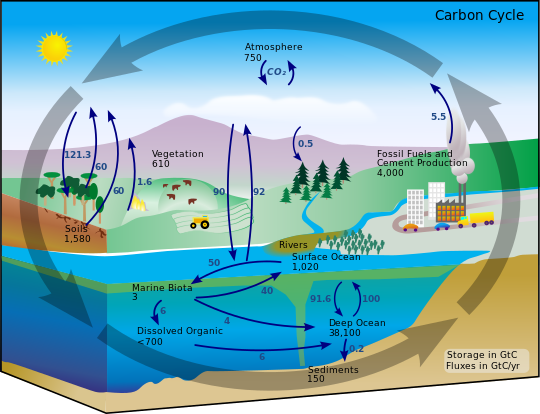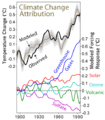From Wikipedia, the free encyclopedia
Green chemistry, also called sustainable chemistry, is a philosophy of chemical research and engineering that encourages the design of products and processes that minimize the use and generation of hazardous substances.[1] Whereas environmental chemistry is the chemistry of the natural environment, and of pollutant chemicals in nature, green chemistry seeks to reduce the negative impact of chemistry on the environment by preventing pollution at its source and using fewer natural resources.
As a chemical philosophy, green chemistry applies to organic chemistry, inorganic chemistry, biochemistry, analytical chemistry, physical chemistry and even chemical engineering. While green chemistry seems to focus on industrial applications, it does apply to any chemistry choice. Click chemistry is often cited as a style of chemical synthesis that is consistent with the goals of green chemistry. The focus is on minimizing the hazard and maximizing the efficiency of any chemical choice.
In 2005 Ryōji Noyori identified three key developments in green chemistry: use of supercritical carbon dioxide as green solvent, aqueous hydrogen peroxide for clean oxidations and the use of hydrogen in asymmetric synthesis.[2] Examples of applied green chemistry are supercritical water oxidation, on water reactions, and dry media reactions.
Bioengineering is also seen as a promising technique for achieving green chemistry goals. A number of important process chemicals can be synthesized in engineered organisms, such as shikimate, a Tamiflu precursor which is fermented by Roche in bacteria.
The term green chemistry was coined by Paul Anastas in 1991.[3] However, it has been suggested[4] that the concept was originated by Trevor Kletz in his 1978 paper in Chemistry and Industry where he proposed that chemists should seek alternative processes to those involving more dangerous substances and conditions.[5] The "Zero Effluent Lab Manual" was developed by Thomas Hellman Morton when he was on the faculty at Brown University in the 1970s. The Manual is still available on-line via links at the Hendrix College Green Chemistry site. Also in Chemistry and Industry the solvent free green chemistry version of “The Hajos-Parrish Cyclisation” has been highlighted in 1996 by Professors Andrew B. Holmes and G. Richard Stephenson.[6]
Principles
Paul Anastas, then of the United States Environmental Protection Agency, and John C. Warner developed 12 principles of green chemistry,[7] which help to explain what the definition means in practice. The principles cover such concepts as:- the design of processes to maximize the amount of raw material that ends up in the product;
- the use of safe, environment-benign substances, including solvents, whenever possible;
- the design of energy efficient processes;
- the best form of waste disposal: not to create it in the first place.
- It is better to prevent waste than to treat or clean up waste after it is formed.
- Synthetic methods should be designed to maximize the incorporation of all materials used in the process into the final product.
- Wherever practicable, synthetic methodologies should be designed to use and generate substances that possess little or no toxicity to human health and the environment.
- Chemical products should be designed to preserve efficacy of function while reducing toxicity.
- The use of auxiliary substances (e.g. solvents, separation agents, etc.) should be made unnecessary wherever possible and innocuous when used.
- Energy requirements should be recognized for their environmental and economic impacts and should be minimized. Synthetic methods should be conducted at ambient temperature and pressure.
- A raw material or feedstock should be renewable rather than depleting wherever technically and economically practicable.
- Reduce derivatives – Unnecessary derivatization (blocking group, protection/deprotection, temporary modification) should be avoided whenever possible.
- Catalytic reagents (as selective as possible) are superior to stoichiometric reagents.
- Chemical products should be designed so that at the end of their function they do not persist in the environment and break down into innocuous degradation products.
- Analytical methodologies need to be further developed to allow for real-time, in-process monitoring and control prior to the formation of hazardous substances.
- Substances and the form of a substance used in a chemical process should be chosen to minimize potential for chemical accidents, including releases, explosions, and fires.
Trends
Attempts are being made not only to quantify the greenness of a chemical process but also to factor in other variables such as chemical yield, the price of reaction components, safety in handling chemicals, hardware demands, energy profile and ease of product workup and purification. In one quantitative study,[8] the reduction of nitrobenzene to aniline receives 64 points out of 100 marking it as an acceptable synthesis overall whereas a synthesis of an amide using HMDS is only described as adequate with a combined 32 points.Green chemistry is increasingly seen as a powerful tool that researchers must use to evaluate the environmental impact of nanotechnology.[9] As nanomaterials are developed, the environmental and human health impacts of both the products themselves and the processes to make them must be considered to ensure their long-term economic viability.
Examples
In the statement for the 2005 Nobel Prize for Chemistry for "the development of the metathesis method in organic synthesis," the Nobel Prize Committee states, "this represents a great step forward for 'green chemistry', reducing potentially hazardous waste through smarter production. Metathesis is an example of how important basic science has been applied for the benefit of man, society and the environment."[10] The concept of green pharmacy was developed recently based on similar principles.[11]Hydrazine
Addressing principle #2 is the Peroxide Process for producing hydrazine without cogenerating salt. Hydrazine is traditionally produced by the Olin Raschig process from sodium hypochlorite (the active ingredient in many bleaches) and ammonia. The net reaction produces one equivalent of sodium chloride for every equivalent of the targeted product hydrazine:[12]- NaOCl + 2 NH3 → H2N-NH2 + NaCl + H2O
- 2 NH3 + H2O2 → H2N-NH2 + 2 H2O
1,3-Propanediol
Addressing principle #7 is a green route to 1,3-propanediol, which is traditionally generated from petrochemical precursors. It can be produced from renewable precursors via the bioseparation of 1,3-propanediol using a genetically modified strain of E. coli.[13] This diol is used to make new polyesters for the manufacture of carpets.Carbon dioxide as blowing agent
In 1996, Dow Chemical won the 1996 Greener Reaction Conditions award for their 100% carbon dioxide blowing agent for polystyrene foam production. Polystyrene foam is a common material used in packing and food transportation. Seven hundred million pounds are produced each year in the United States alone. Traditionally, CFC and other ozone-depleting chemicals were used in the production process of the foam sheets, presenting a serious environmental hazard. Flammable, explosive, and, in some cases toxic hydrocarbons have also been used as CFC replacements, but they present their own problems. Dow Chemical discovered that supercritical carbon dioxide works equally as well as a blowing agent, without the need for hazardous substances, allowing the polystyrene to be more easily recycled. The CO2 used in the process is reused from other industries, so the net carbon released from the process is zero.Lactide
In 2002, Cargill Dow (now NatureWorks) won the Greener Reaction Conditions Award for their improved method for polymerization of polylactic acid . Unfortunately, lactide-base polymers do not perform well and the project was discontinued by Dow soon after the award. Lactic acid is produced by fermenting corn and converted to lactide, the cyclic dimer ester of lactic acid using an efficient, tin-catalyzed cyclization. The L,L-lactide enantiomer is isolated by distillation and polymerized in the melt to make a crystallizable polymer, which has some applications including textiles and apparel, cutlery, and food packaging. Wal-Mart has announced that it is using/will use PLA for its produce packaging. The NatureWorks PLA process substitutes renewable materials for petroleum feedstocks, doesn't require the use of hazardous organic solvents typical in other PLA processes, and results in a high-quality polymer that is recyclable and compostable.
Carpet tile backings
In 2003 Shaw Industries selected a combination of polyolefin resins as the base polymer of choice for EcoWorx due to the low toxicity of its feedstocks, superior adhesion properties, dimensional stability, and its ability to be recycled. The EcoWorx compound also had to be designed to be compatible with nylon carpet fiber. Although EcoWorx may be recovered from any fiber type, nylon-6 provides a significant advantage. Polyolefins are compatible with known nylon-6 depolymerization methods. PVC interferes with those processes. Nylon-6 chemistry is well-known and not addressed in first-generation production. From its inception, EcoWorx met all of the design criteria necessary to satisfy the needs of the marketplace from a performance, health, and environmental standpoint. Research indicated that separation of the fiber and backing through elutriation, grinding, and air separation proved to be the best way to recover the face and backing components, but an infrastructure for returning postconsumer EcoWorx to the elutriation process was necessary. Research also indicated that the postconsumer carpet tile had a positive economic value at the end of its useful life. EcoWorx is recognized by MBDC as a certified cradle-to-cradle design.Transesterification of fats
In 2005, Archer Daniels Midland (ADM) and Novozymes won the Greener Synthetic Pathways Award for their enzyme interesterification process. In response to the U.S. Food and Drug Administration (FDA) mandated labeling of trans-fats on nutritional information by January 1, 2006, Novozymes and ADM worked together to develop a clean, enzymatic process for the interesterification of oils and fats by interchanging saturated and unsaturated fatty acids. The result is commercially viable products without trans-fats. In addition to the human health benefits of eliminating trans-fats, the process has reduced the use of toxic chemicals and water, prevents vast amounts of byproducts, and reduces the amount of fats and oils wasted.Bio-succinic acid
In 2011, the Outstanding Green Chemistry Accomplishments by a Small Business Award went to BioAmber Inc. for integrated production and downstream applications of bio-based succinic acid.Succinic acid is a platform chemical that is an important starting material in the formulations of everyday products. Traditionally, succinic acid is produced from petroleum-based feedstocks. BioAmber has developed process and technology that produces succinic acid from the fermentation of renewable feedstocks at a lower cost and lower energy expenditure than the petroleum equivalent while sequestering CO2 rather than emitting it.[14]
Laboratory chemicals
Several laboratory chemicals are controversial from the perspective of Green chemistry. The Massachusetts Institute of Technology has created the [2] to help identify alternatives. Ethidium bromide, xylene, mercury, and formaldehyde have been identified as "worst offenders" which have alternatives.[15] Solvents in particular make a large contribution to the environmental impact of chemical manufacturing and there is a growing focus on introducing Greener solvents into the earliest stage of development of these processes: laboratory-scale reaction and purification methods. In the Pharmaceutical Industry, both GSK[16][17] and Pfizer[18] have published Solvent Selection Guides for their Drug Discovery chemists.Legislation
Europe
In 2007, Europe put into place the Registration, Evaluation, Authorisation, and Restriction of Chemicals (REACH) program, which requires companies to provide data showing that their products are safe. This regulation (1907/2006) ensures not only the assessment of the chemicals' hazards as well as risks during their uses but also includes measures for banning or restricting/authorising uses of specific substances. ECHA, the EU Chemicals Agency in Helsinki, is implementing the regulation whereas the enforcement lies with the EU member states. The US Toxic Substances Control Act, passed in 1976, in principle has similar provisions but is not comparable to REACH as to its regulatory effectiveness.On September 29, 2008 California approved two laws which encourage green chemistry, launching the California Green Chemistry Initiative. The law requires California's Department of Toxic Substances Control to prioritize "chemicals of concern", and puts the burden of testing on the agency rather than industry. The laws were criticized by Paul Anastas, who stated that the laws did not go far enough in encouraging research, education, and industry incentives.[19] The law called for regulations to be in place by January 1, 2011, but universal opposition to the previously proposed regulations rendered that date impossible. Mid October 2012 is the new target date for new draft regulations to be in place to implement the law.[20]
United States
Passed in 1990, the Pollution Prevention Act helped create new approaches for dealing with pollution by preventing problems before they happen.It has been stated that long-standing weaknesses in the U.S. chemical management program, notably the Toxic Substances Control Act (TSCA) of 1976, discounts the hazardous properties of chemicals relative to their function, price, and performance.[21] The report concludes that these market conditions represent a key barrier to the scientific, technical, and commercial success of green chemistry in the U.S., and that fundamental policy changes are needed to correct these weaknesses.[22]
Education
Many institutions offer courses[23] and degrees on Green Chemistry. Examples from across the globe are Denmark's Technical University,[24] and several in the US, e.g. at the Universities of Massachusetts-Boston,[25] Michigan,[26] and Oregon.[27] A masters level course in Green Technology, has been introduced by the Institute of Chemical Technology, India. In the UK at the University of York[28] University of Leicester, Department of Chemistry and MRes in Green Chemistry at Imperial College London. In Spain different universities like the Universidad de Jaume I[29] or the Universidad de Navarra,[30] offer Green Chemistry master courses. There are also websites focusing on green chemistry, such as the Michigan Green Chemistry Clearinghouse at www.migreenchemistry.org.Apart from its Green Chemistry Master courses the Zurich University of Applied Sciences ZHAW presents an exposition and web page "Making chemistry green" for a broader public, illustrating the 12 principles.[31]
Scientific journals specialized in green chemistry
Controversy
Following historical analyses of the green chemistry development, there have been green chemistry advocates who see it as an innovative way of thinking. On the other hand, there have been chemists who have argued that green chemistry is no more than a public relations label. In fact, a lot of chemists use the term "green chemistry" independently from the green chemistry paradigm, as proposed by Anastas and Warner. This explains the uncertainty of the scientific status of green chemistry.[32]Awards
Many scientific societies have created awards to encourage research in green chemistry.- Australia’s Green Chemistry Challenge Awards overseen by The Royal Australian Chemical Institute (RACI).
- The Canadian Green Chemistry Medal.[33]
- In Italy, Green Chemistry activities center around an inter-university consortium known as INCA.[34]
- In Japan, The Green & Sustainable Chemistry Network oversees the GSC awards program.[35]
- In the United Kingdom, the Green Chemical Technology Awards are given by Crystal Faraday.[36]
- In the US, the Presidential Green Chemistry Challenge Awards recognize individuals and businesses.[37][38]
























